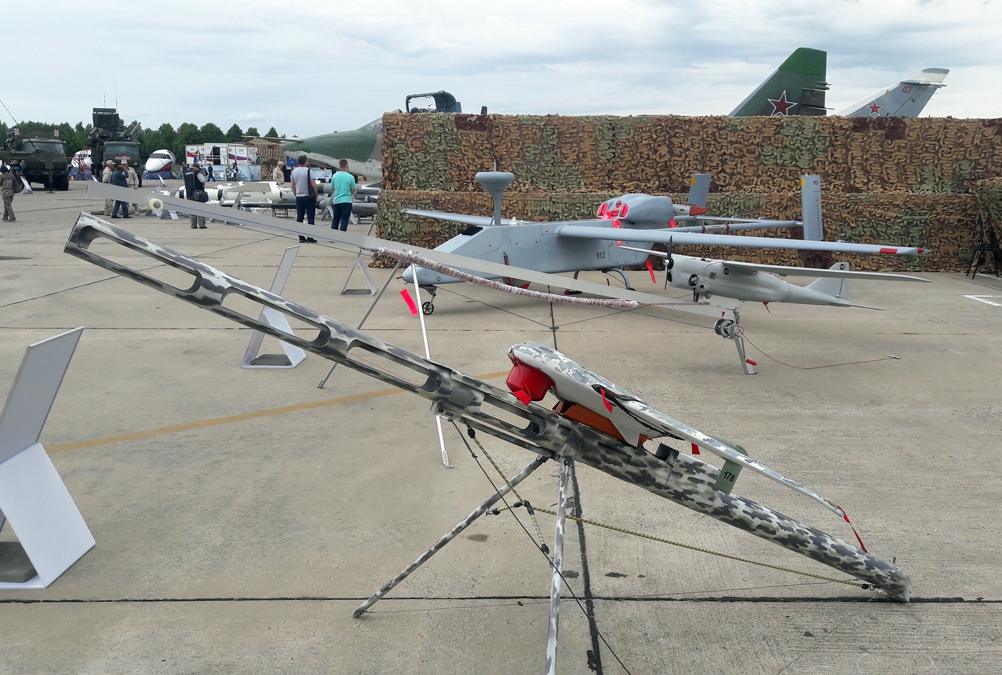
This display at the Army 2019 exhibition showcases the primary UAV types used by Russia in Syria, comprising the Eleron-3 (foreground), Orlan-10 and Forpost
The Russian defense ministry is going to spend a billion roubles ($15.5 million) on procuring the Eleron-3 lightweight unmanned aerial vehicle (UAV) in 2019-2021, according to an announcement on the ministry’s website earlier this month.
The announcement follows a number of news and video releases in August-September that depicted experimental examples of the Altius-U and Forpost-R long-endurance reconnaissance UAVs undergoing flight trials. Also, the MoD released a video of the S-70 Okhotnik UCAV in formation flight with a Sukhoi Su-57 fifth-generation fighter.
These releases reveal the considerable progress that Moscow has achieved in unmanned aerial technologies. Today, the Russian army possesses around 4,000 units, placing it among the world’s three largest UAV operators; together with the U.S. armed forces and China’s People’s Liberation Army.
Since the Russian expeditionary force landed in Syria, its drones have performed over 23,000 flights lasting 140,000 hours. Operational since 2012, the 4-kg (9-lb) Eleron-3 has made a considerable contribution to these figures, and a number have been lost to technical failures and rebel fire. Despite downed Eleron-3s falling into hostile hands, the MoD has made the decision to place a large order for an improved variant that features longer endurance, improved software, and additional optical sensors. The battery-powered Eleron-3 enables ground operators to carry out visual searches for targets of opportunity in daylight and to determine their location using GLONASS satellite-aided navigation.
The largest drone that Russia flies in numbers over Syria has been the Forpost, a licensed copy of the IAI Searcher II, of which about 100 have been built since 2012. It provided a platform for development of the Forpost-R, which is set to enter service next year. The “R” version is completely “Russianized,” with imported engines having been replaced by the indigenous 83-hp APD-85. This allows for an increase in gross weight from 436 kg (962 lb) to 500 kg (1,102 lb), and endurance rises to 18 hours. According to an MoD statement,
“the system has acquired new capabilities thanks to state-of-the-art technologies of local origin, including those concerned with round-the-clock surveillance using not only optical equipment, but also that of radar and electronic warfare means.”
In the meantime, the Russian expeditionary force faces an ever-growing threat from Syrian rebel drones. According to the MoD, during the last 24 months, the air defense systems of the Khmeimeem and Tartus military bases have shot down 118 hostile UAVs, including 58 since January 1, 2019. Additionally, the Pantsyr S1 and Tor-M2 short-range SAMs have fired 31 missiles to intercept 27 rockets launched at the bases from the Idlib de-escalation zone since the beginning of this year.
According to MoD spokesman General Igor Kanashenkov,
“the drones assembled by the terrorists can cover up to 150 km [81 nm] and attain a maximum altitude of 4,000 meters [13,000 ft]. There is little doubt that the terrorists receive outside help to produce them. While these drones may look amateurish, they make use of very advanced technical solutions developed by skilled professionals. Their technical level has been growing.” The Russian forces recently downed a rebel-operated UCAV equipped with a navigation system with three receiving antennas, he added.
Earlier, another Russian official, deputy defense minister for military technical cooperation with foreign countries General Aleksandr Fomin, accused U.S. forces of assisting the Syrian rebels in carrying out drone attacks on the Khmeimeem airbase. Speaking at the Xiangshan security forum in Beijing last fall, he said that,
“a group of 13 drones moved according to a common plan of combat deployment, under control of a single crew team. That time, a U.S. Navy P-8 Poseidon ASW aircraft was on an eight-hour patrol mission over the Mediterranean Sea. Upon reaching out our electronic warfare shield, the drones retreated somewhat to receive correcting instructions and began using satellite communications channels to receive outside assistance to find and explore gaps in that shield. Then the drones attempted to penetrate through, only to be destroyed.”
Apparently, Fomin was referring to January 6, when Russian forces shot down seven drones with anti-aircraft missiles and crash-landed seven by jamming the drones’ flight control systems. Moscow promises to reveal additional information on its recent anti-drone experience at the ninth Xiangshan forum to be held October 20-22.
Photo: Vladimir Karnozov
Source: AIN
